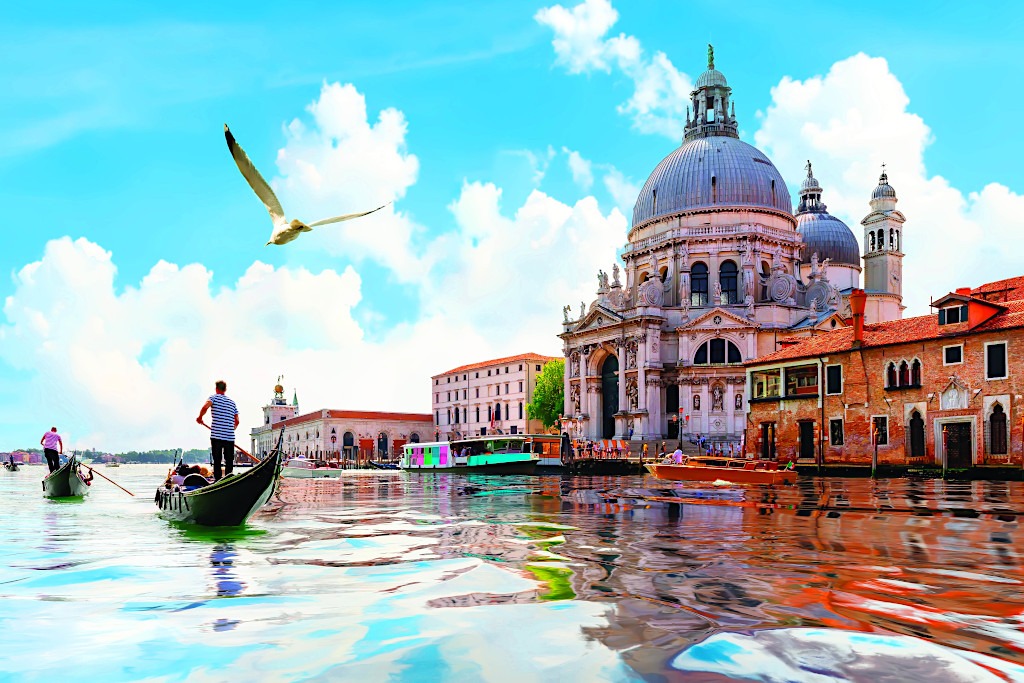ROME
I’ll admit, I had a slightly ulterior motive for my return to Rome: I never got to see the Colosseum. So with that first priority, we headed to Palatine Hill and the Roman Forum, and at last got to behold the immensity of the firstcentury A.D. amphitheater, with VIP access to its underground and arena floors with Walks of Rome (www.walksofitaly.com/rome-tours). The Colosseum is impressive for its size alone, but the architecture lover in me was captivated by the ingenuity of its engineers, whose work has left this gigantic relic standing proudly in the heart of Rome since 70 A.D. Even as the wooden floor and canopies have disappeared, along with its decorative marble cladding, this amphitheater built of travertine and limestone (but without an ounce of mortar) lives on and welcomes 4.2 million visitors a year. For us, the Colosseum still holds the ghosts of antiquity, and now the residue of our spirits are there too.

River Tiber
Not surprisingly, eating followed. Denise and I explored the trattorias of Rome’s old Jewish Ghetto with Walks guide and trained chef Marta, who introduced us to the fried artichokes that are considered one of the neighborhood’s prized delicacies. I’m already a big fan of artichokes, but the crispy purity of “carciofi alla Giudia” (literally, “Jewish style artichokes”) was new to me. They’re prepared using the hearts and only the soft outer leaves, soaked in lemon water, then seasoned and deep fried in olive oil, before appearing on a plate like crunchy-leafed sunflowers.
Marta also introduced us to the fine points of Roman pizza at Origano (Largo dei Chiavari 84. Tel: 39-06-6880-8074. www.origanocampodefiori.com), noting that it must be a thin crust, and the fewer toppings the better.
At Fatamorgana Chiavari (Via dei Chiavari 37A. Tel: 39 06 8881 8437. www.gelateriafatamorgana.com) we discovered that truly great gelato may come in uncommon flavors, be it acai, sesame, wasabi, or all sorts of variations on traditional flavors. A steal at €2.50 for two scoops (up to €5 for five scoops), I couldn’t resist a cone of classic pistachio with Venezuelan chocolate, and I thought about it for days.
Denise and I picked up morsels of history along the route to Piazza Navona, passing the famous Campo de Fiori market square, and the awe striking domed Pantheon. Then, just before sunset, we ascended to a private rooftop for a Pasta-Making Class with Local Chefs (www.walksofitaly.com/rome-tours/romecooking-class), one of Walks’ signature experiences. Chefs Denyse and Julia earned immediate points by pouring our small group glasses of prosecco and sharing cheese, prosciutto, and other Roman appetizers.
Then my inner chef got answers to every question about homemade pasta, satisfying my curiosities along with my appetite. We learned how to mix flour and egg just right, how to properly set a pasta press for thickness, and how to fill ravioli. Most importantly, we learned that of Italy’s hundreds of types of pasta, each one is paired only with one particular sauce, which is why Bolognese ragu is served with tagliatelle, carbonara with spaghetti, cinghiale (wild boar) with pappardelle, linguini with arrabiata, etc. And FYI, meatballs remain a standalone dish, and lasagna should be served only on Sundays.

The Spanish Steps in Rome
The next morning we meandered through Rome, revisiting sites from our more youthful days. Walking is always the best way to explore a city, but Rome felt especially lovely in those quiet early hours. We covered much ground by following the promenade of the River Tiber, where musicians, artists, and lovers sat perched along the way. We discovered the cobblestoned streets of Isola Tiberina, the river’s only island. Then we drifted into the cool district of Trastevere, where by midday, the cafés had come alive with patrons sipping espresso under ivy-covered awnings.
We headed up to lovely Parco di Gianicolo, to take in views from its lush hilltop, and visit the fountains, monuments, and small botanical garden (which once served as the pope’s private medicinal garden). Along the way, we discovered another gem in Villa Farnesina (Via della Lungara 230. Tel: 39-06-6802-7268. www.villafarnesina.it), a marvelous Renaissance villa-turned-museum. Built in 1510 by a papal treasurer, the villa is home to frescoes by Raphael and other famous artists of the era. It felt a little more magical as a place we stumbled upon, and better still, had few enough visitors that we could simply absorb its beauty.
Later that day, as we wound up in the thick of the tourist crowds by the Trevi Fountain and Spanish steps, I began to appreciate more deeply how even in the busiest cities, there’s always a way to wander apart from the masses. A unique experience can be a gift from a smart tour company or guide; a destination-free passeggiata (a leisurely walk); or an insider’s tip shared over spontaneous aperitivi. As travelers, we just have to heed locals’ advice, and dare to venture beyond the beaten path.


